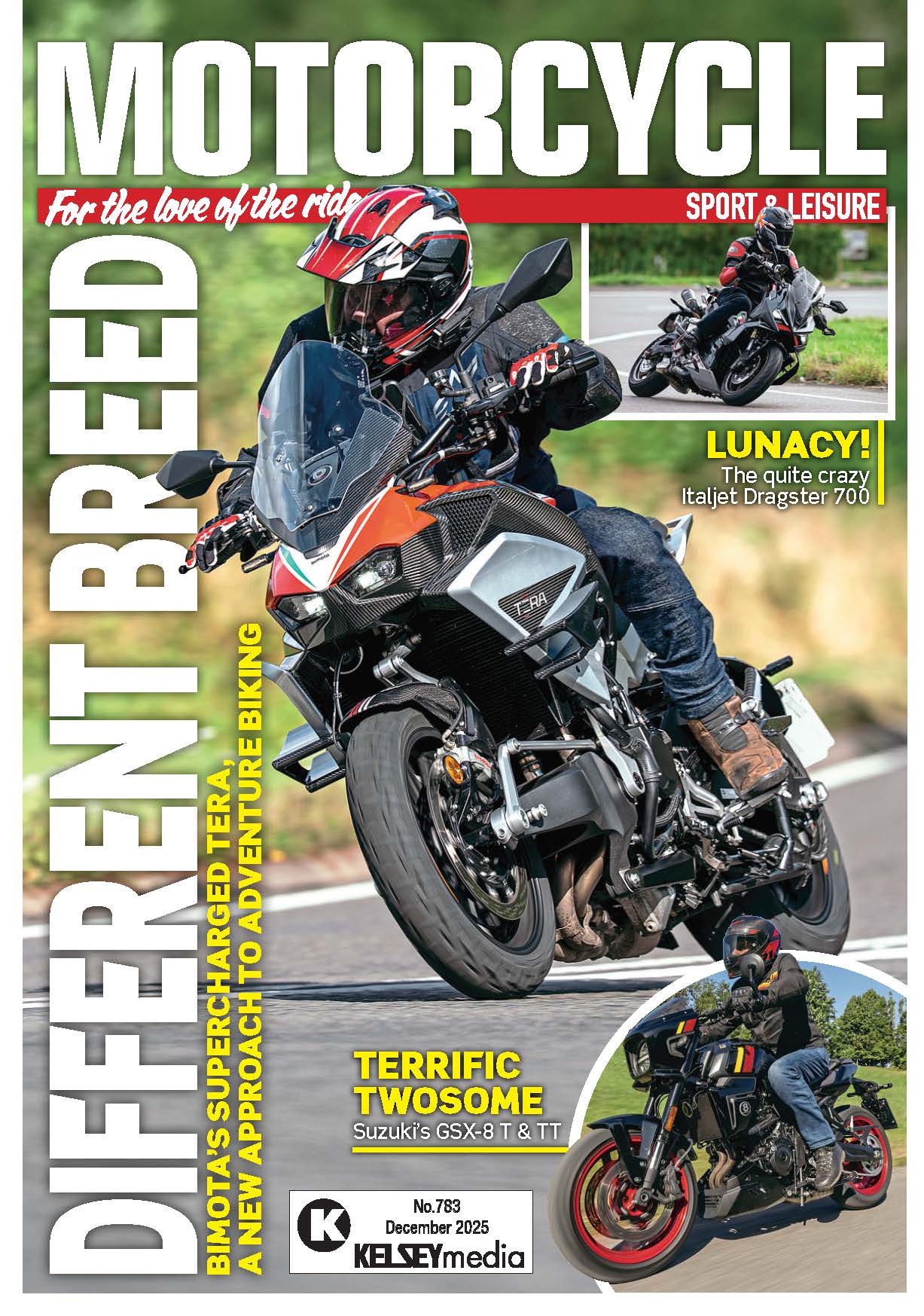Regardless of the figures for power output, torque and weight, or for the issues the company has been going through over the last half a year or so, the very first comment from any bystander with regard to the 1390 Super Duke R is always about the way that it looks…
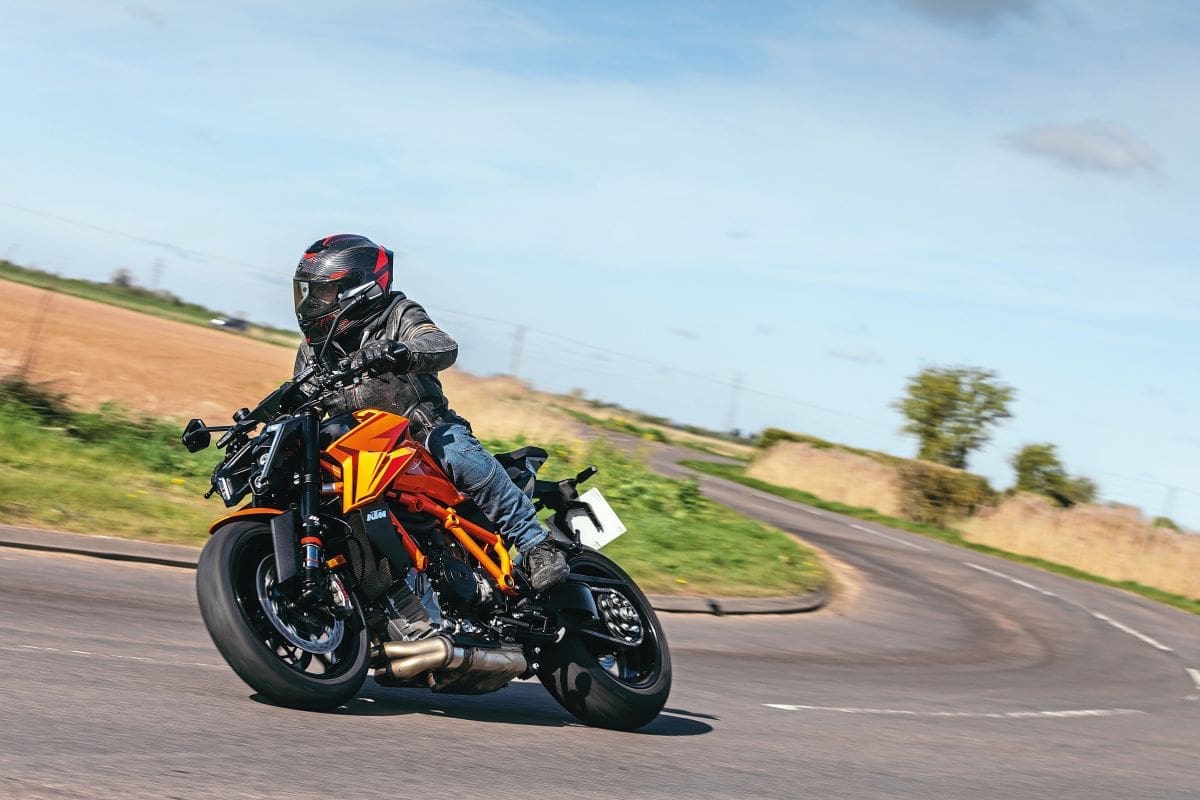
Words: Dave Manning Photography: Gary Chapman
Whether you like it or not, you cannot argue the fact the Super Duke’s aesthetics are striking. Like a splitting axe to your mandibles striking. I seem to be in the minority when I admit that I like it, as most folk resort to a number of varied and interesting expletives when they describe the styling. Perhaps the most important element here is that it is different to pretty much any other bike from any other manufacturer.
KTM have managed to do this while also keeping a family aesthetic, with various elements of the design harking back to earlier models, and the 1390 Super Duke has a side profile that is remarkably similar to the 990 Super Duke launched way back in 2005 – particularly the bulldog profile of hunched shoulders and minimalist rear end brought by a broad and chunky fuel tank (or, rather, the fuel tank cover) and postage stamp pillion seat.
Enjoy everything More Bikes by reading the MoreBikes monthly newspaper. Click here to subscribe, or Read FREE Online.
And there are elements of the design that help with the aim of improved performance, with the minimalist subframe and pillion provisions having a low weight. The new, angular headlight actually reduces mass by an impressive 700g – although many folk are referring to it as HR Geiger influences or the Predator from the eponymous film of 1987! When a manufacturer strives to reduce weight wherever possible, and only a few grammes are heralded as a great step forward, having nigh on three-quarters of a kilogram dropped from the front of the bike is quite astounding. As an aside, the brightness of those front lights varies automatically in accordance to the ambient light levels. And they also have a ‘Coming Home’ function, remaining lit for a short while after the bike is turned off.
But, of course, you’re not looking at the aesthetics of a bike when you’re riding it. So that’s what I shall do.
It immediately feels tall, and while I could get my feet flat on the ground, it’s only just, and the riding position is quite tipped forward for a naked. But then this is, of course, no basic naked bike, and it genuinely deserves the term hyper-naked, as with a genuine 180bhp on tap (the factory claim 190bhp). There is a requirement to be tipped forward if you’re wanting to use the throttle with any kind of urgency. The pitched-forward riding position is allied to a firm feel to the suspension, reminiscent of sports bikes, and if you think the Super Duke is a more comfortable alternative to a genuine sportsbike then while it is most certainly a little roomier, you may want to take a test ride before you commit, as the rigid suspension only really starts to work at a certain pace. On the bumpy nadgery lanes that I like riding the most, it’s rather harsh on the wrists. But saying all that is rather academical, as the WP suspension front and rear is fully adjustable, and you could tweak it to suit you and the type of riding you enjoy most. I altered nothing, so my comments are close to being null and void. (The higher spec Evo version has semi-active WP suspension front and rear).
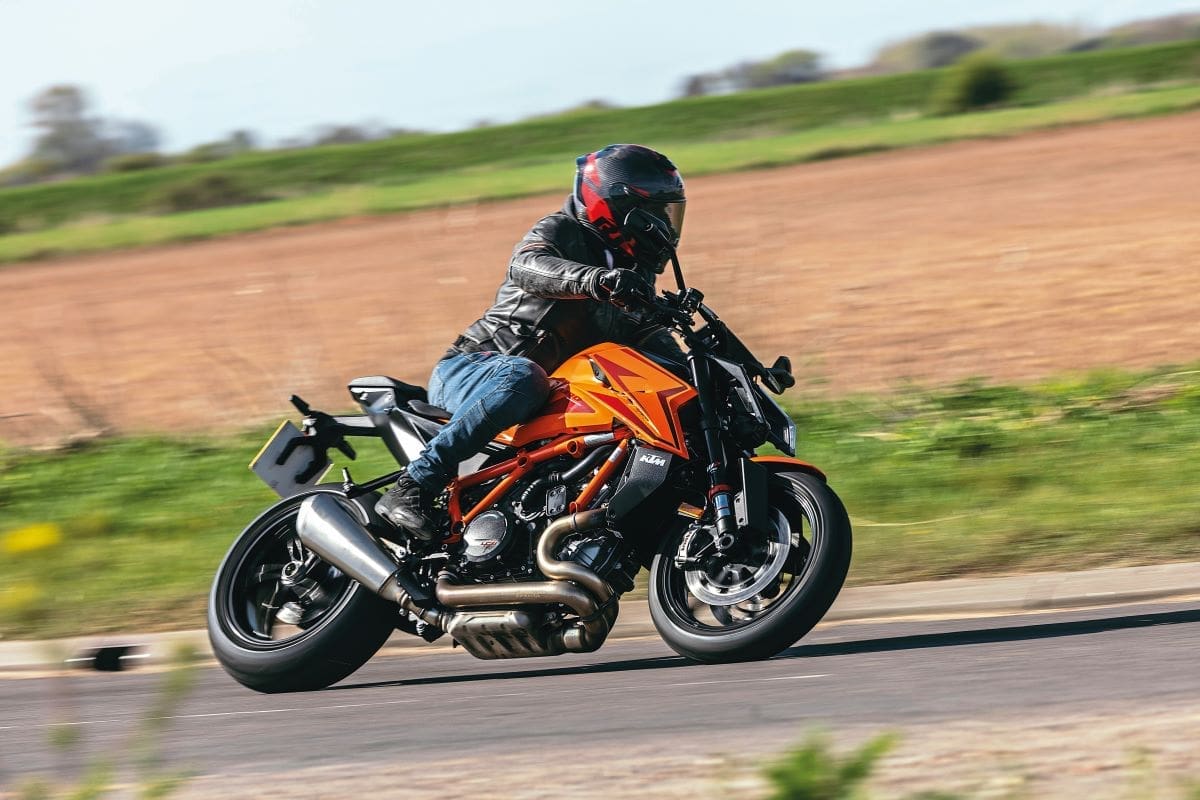
The fuel tank feels broad, but then at 17.5 litres it is bigger than earlier Super Duke fuel receptacles, so it’ll be more practical than the very early 990 versions which had a tank range barely further than the end of your drive…
It feels very tall geared, and while it’s fair to say that a big capacity vee twin generally doesn’t like high gears at low revs – and this is a big twin, although true capacity is actually 1350cc, rather than what the name suggests – it will actually pull fourth gear from under 40mph without much complaint. But it’s far happier when in lower gears in speed-limited areas, saving it’s top two ratios for more open roads.
While the standard exhaust isn’t exactly whisper quiet (and does feel a little intrusive on its high tickover), it’s not overly noisy, and neither is the induction noise, although it does make a very pleasing sound when accelerating from about 2,000rpm. Starting with a grumbly purring through 3,000rpm, growing to a roar and a bark right at the top end of the rev range, it’s an addictive soundtrack that revels in the midrange. Rolling on and off the throttle in one gear through twisty lanes brings a melodic overture to fun.
While you’re enjoying the soundtrack, you do realise you’re covering ground at an impressive rate. But don’t be thinking that statement means you’re doing speeds that are totally inappropriate for public roads, as that isn’t necessarily the case (although entirely possible – one could say that the KTM encourages it). What that big vee twin is really good at is overtaking. No, that’s not the right turn of phrase. What the Super Duke excels at is punching past slower moving traffic in less than the blink of an eye, and actually makes overtakes a safer process. It’s almost as if the KTM development team went on an advanced riding course, and took the instructor’s comment of “Make each and every overtake as swiftly and smoothly as possible” and ran with it, making it the prime aim of their product.
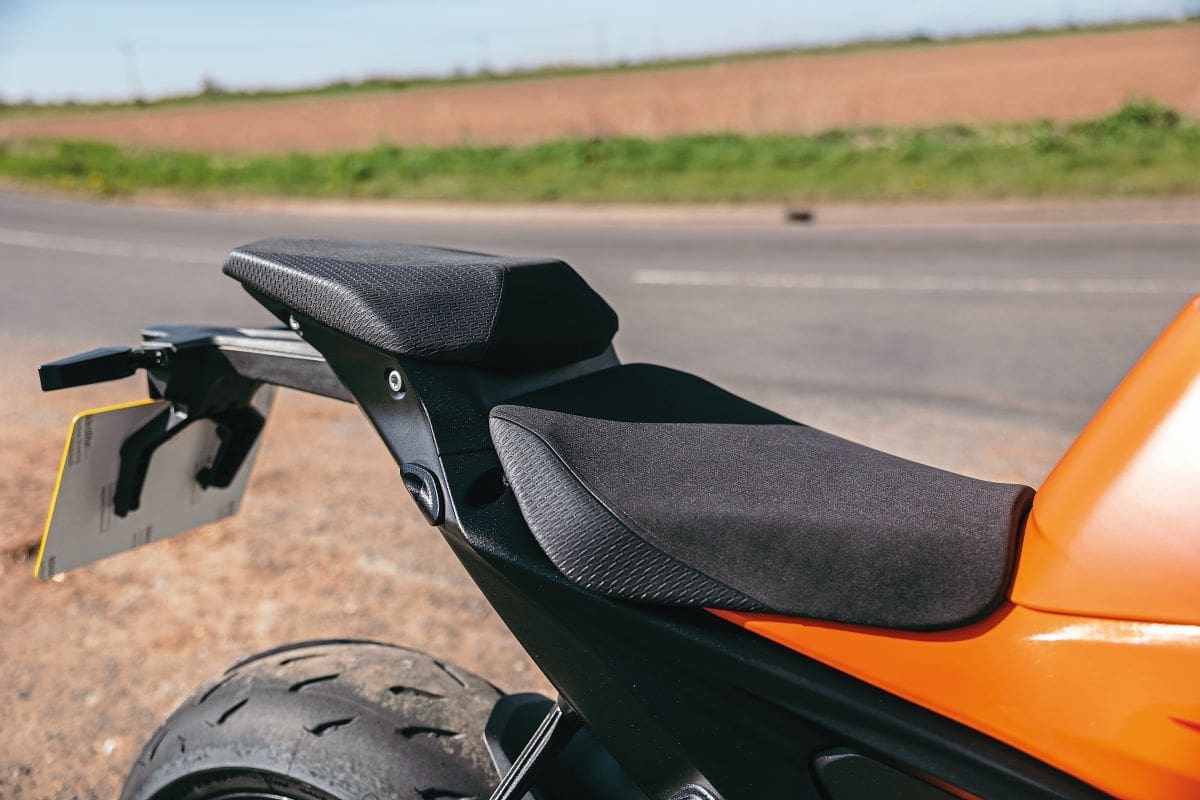
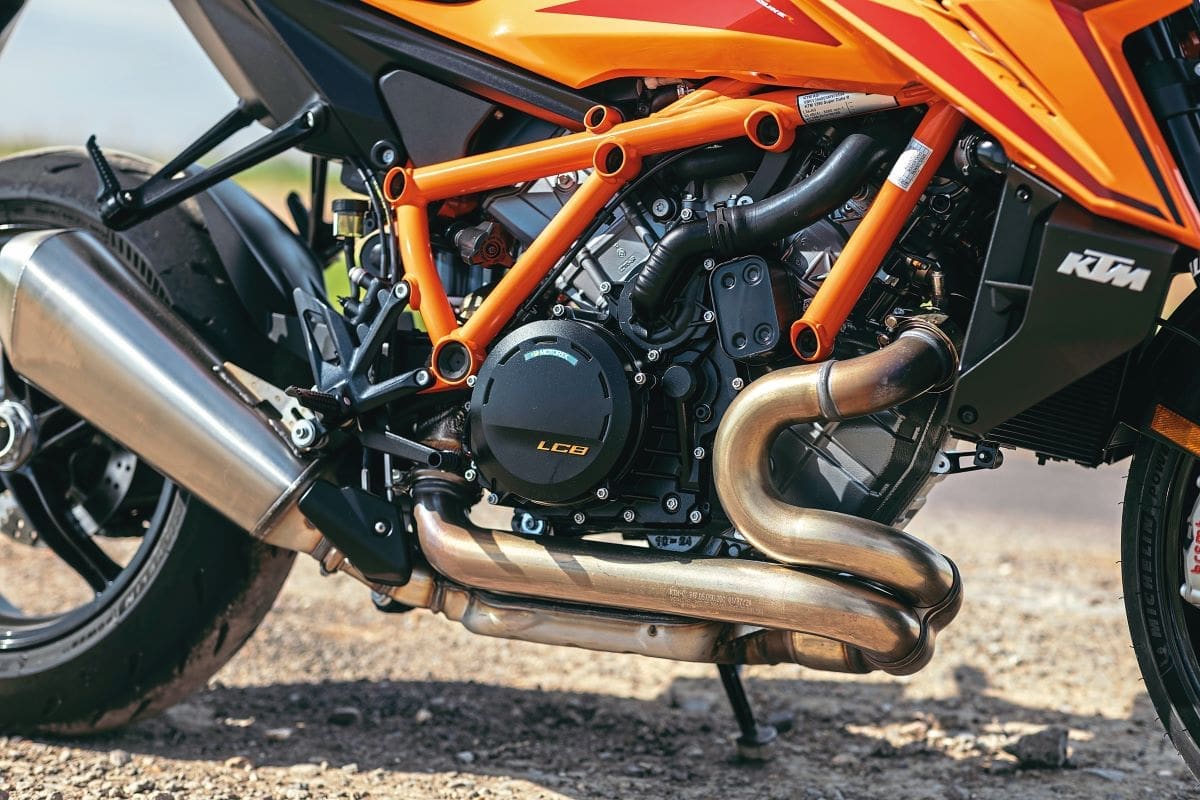
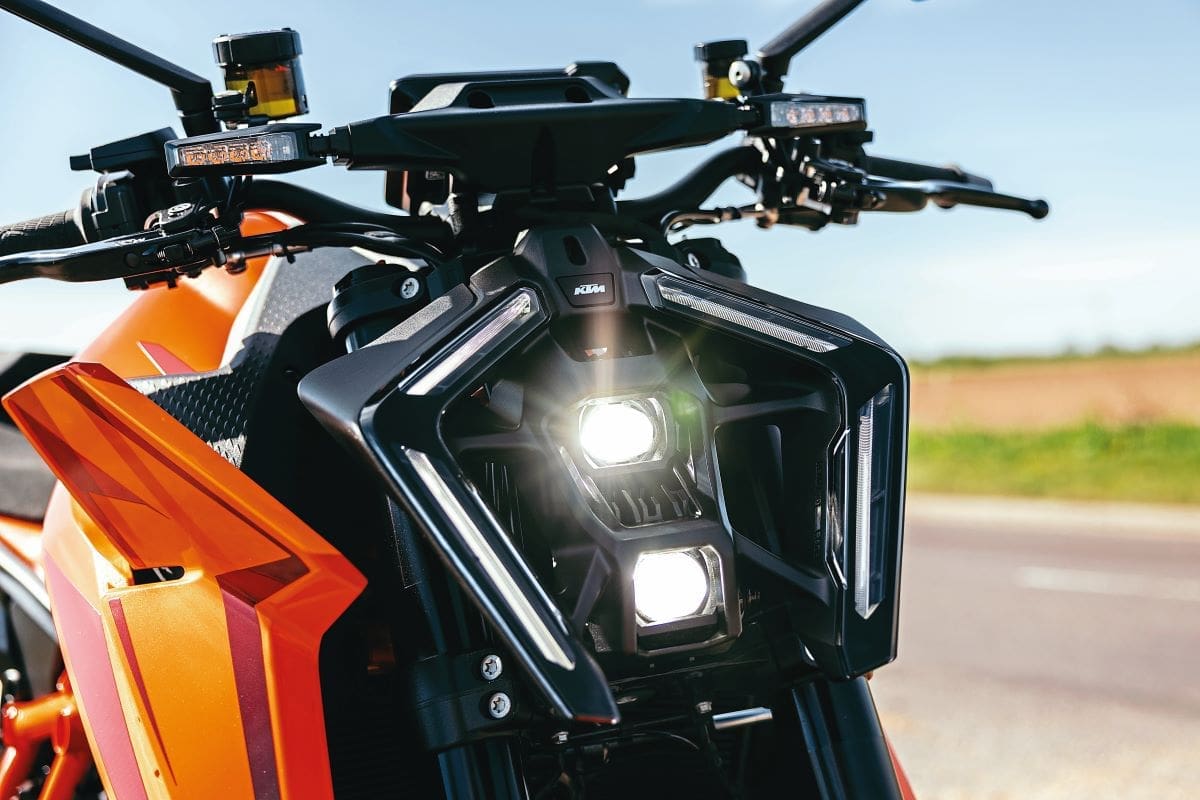
As per each and every hyper-naked on the market right now, the Super Duke has an expansive suite of electronics. And, being brutally frank, they’re invariably electronics I either have no interest in messing with, or if I do then I struggle to find the time to mess about and learn what they do and where they are, when all I really want to do (and with a premium on time) is ride. That said, I will always have a quick twiddle, pressing and prodding various buttons and switches to see what I can change and how quickly they can be changed, and also to see if I can easily remember where things are. Usually, this involves a change of rider modes to see how that affects the throttle response and feel. With pretty much each and every bike I have ridden in recent times I’ve ended up at a setting that is Street or Sport (for me, softer settings such as Rain are invariably left unused as almost every bike built of late has a perfectly acceptable throttle action. The age-old saying of the bike only going as fast as you twist the throttle is just as apt now as it was 30 years ago.)
Essentially, aside from cruise control, ABS etc, the rider aids concern the three rider modes of Street, Sport and Rain (with the first two having full power, while Sport has a slightly more aggressive throttle response and allows some wheel slip, while Rain reduces the output to 130bhp) as well as the inevitable dash connection to your device via the appropriate app that allows turn-by-turn sat nav etc.
Regarding that tech, there is the ‘locked’ area of tech that is open for the first 900 miles and then has to be bought to be unblocked, with two options – the Tech pack at £850.81 and the Track pack costing another £452.15. The former contains the quickshifter, MSR (Motor Slip Regulation), adaptive brake light, and engine brake control, while the Track package brings adjustable traction control, wheelie control (which can be turned off entirely), and Launch Control but also, rather bizarrely, disables the cruise control and the dash app connectivity. The thought presumably being that you’ll be using the Track mode when (obviously) on track at a track day, and using cruise control (or needing sat nav, or being able to answer your phone) has no place on a track day… The Track mode also gives an extra screen option that can show the bike’s telemetry, the lap timer, lean angle, and G forces. Really rather clever if you’re into that sort of thing, but I do wonder how easy it is to pay attention to such things when you’re fully committed on a track day! And isn’t that a little contrary to the other options being switched off?
One thing I was keen to check out on the 1390 was the wheelie control, for a couple of reasons. Now, I would love to be able to pull wheelies. I’ve always wanted to have that particular talent, yet never been able to summon the requisite skills or, for that matter, the time and place in which to try and pull together enough ability to be able to ham it up for the camera (which some may consider a necessity for a bike journo, but I’ve got away with it so far). The Super Duke R brings that ability to the masses, with the finesse of the wheelie control system allowing you to choose from Very Low, Low, Medium, High and Very High (yet, rather peculiarly, KTM refer to it as “Anti-wheelie” while it would probably be better referred to as ‘wheelie assist’). It took some finding to start with, and then I couldn’t find it a second time. I did get the feeling the Super Duke was toying with me and moving the electronic controls around so I couldn’t change the things I wanted to…
I did finally manage to find, and alter, the wheelie control settings but, with a focus on covering ground and exploring some lanes north of the Humber, I wasn’t actually in the position to compare different settings over the same stretch of tarmac, and consequently wasn’t able to truly find out if the big KTM can give me the apparent talent that I clearly lack. Although I did find the settings that give a higher lift to the front end did seem to allow the front to rise a bit more under hard acceleration and, particularly on the roads that I rode that day, over crests and rises but without the heart-in-mouth adrenaline rush of the front rising so fast that you have to chop the throttle or stamp on the rear brake, as I’ve found with other, equally-as-feisty bikes (notably, various turbocharged machines I’ve ridden in the past). What this suggested to me is that the wheelie control is actually rather efficient at tempering the power output to allow harder throttle opening and consequently faster riding while also opening up opportunities to show off for those who like to draw attention to themselves. Quite how either of those apply to today’s congested roads is open to debate. And, for a large number of MSL readers, there’ll be the question of whether 180bhp is really needed. And, we’ve got to be honest here, no, it isn’t needed. But it is, unquestionably, a huge amount of fun and very, very rewarding to ride.
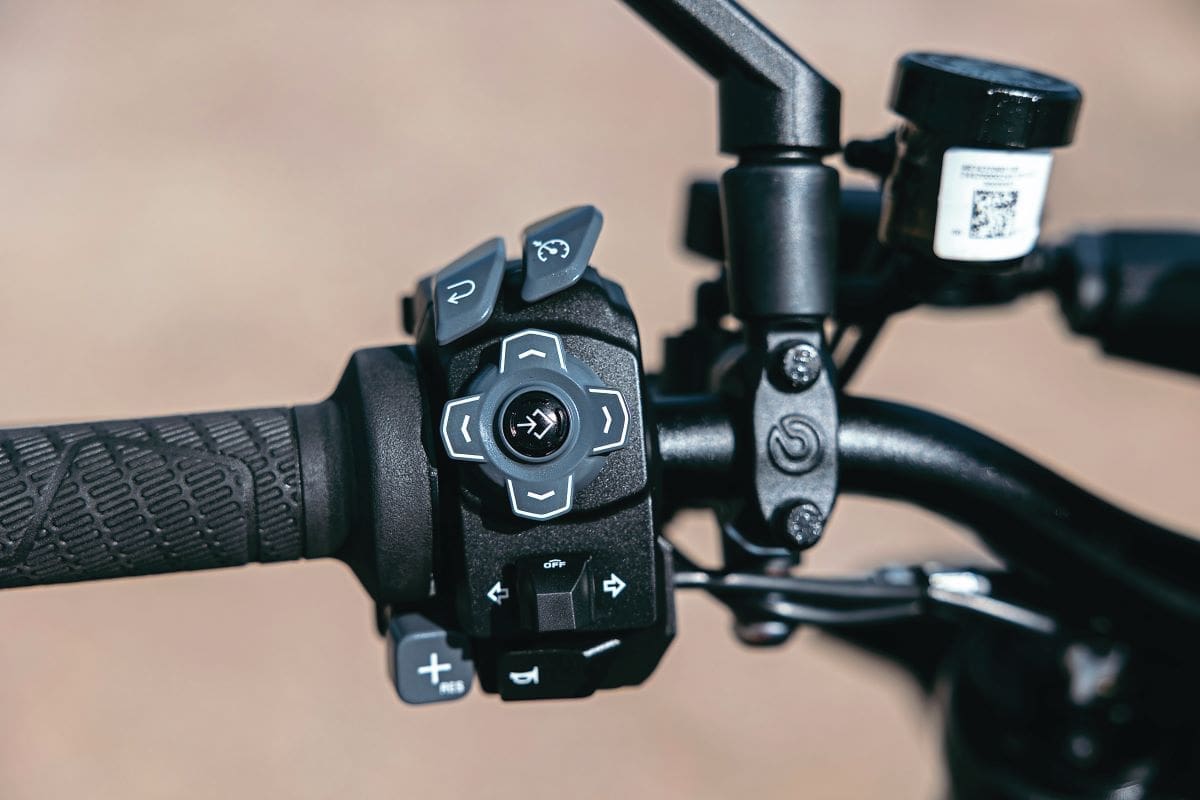
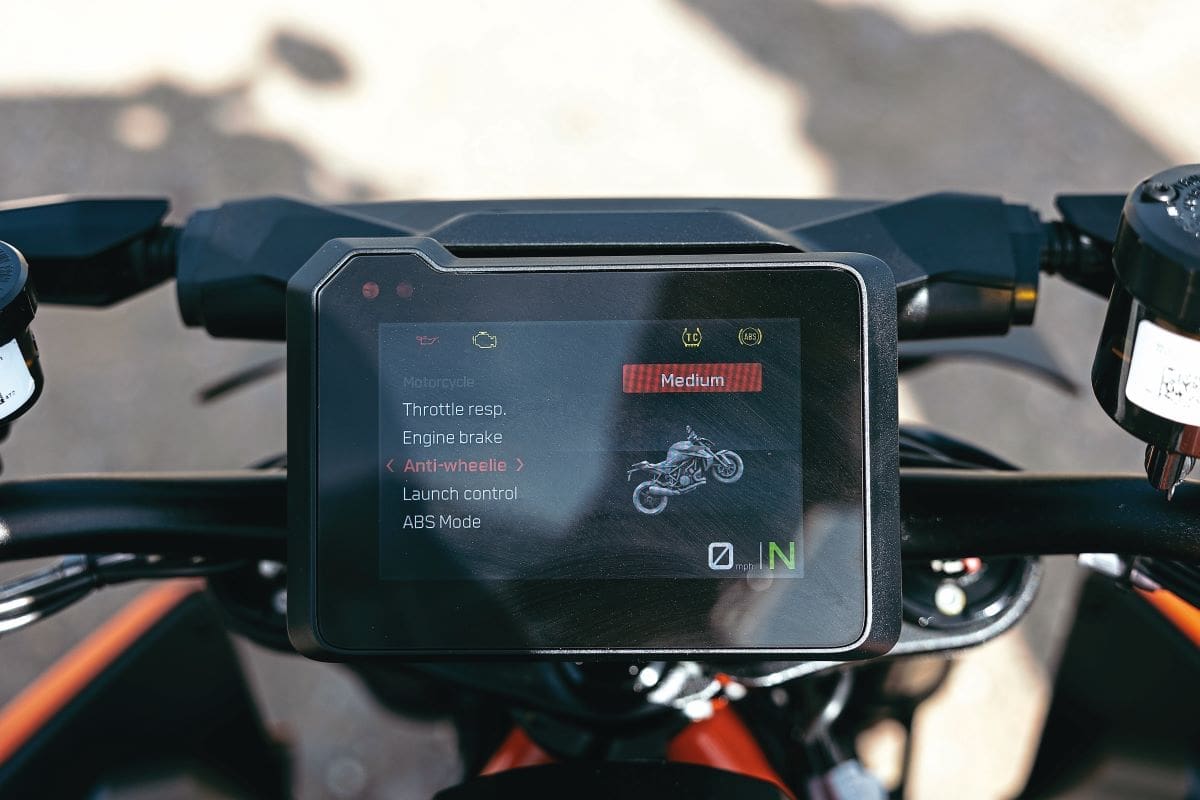
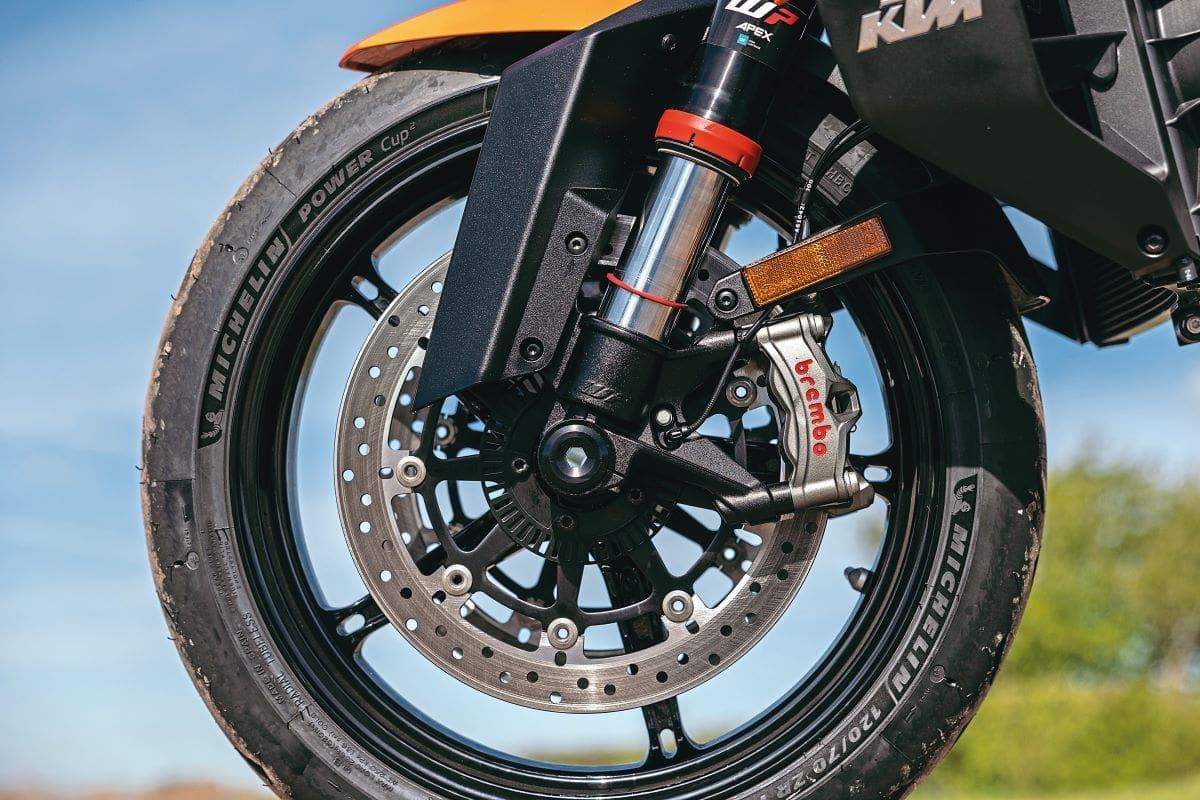
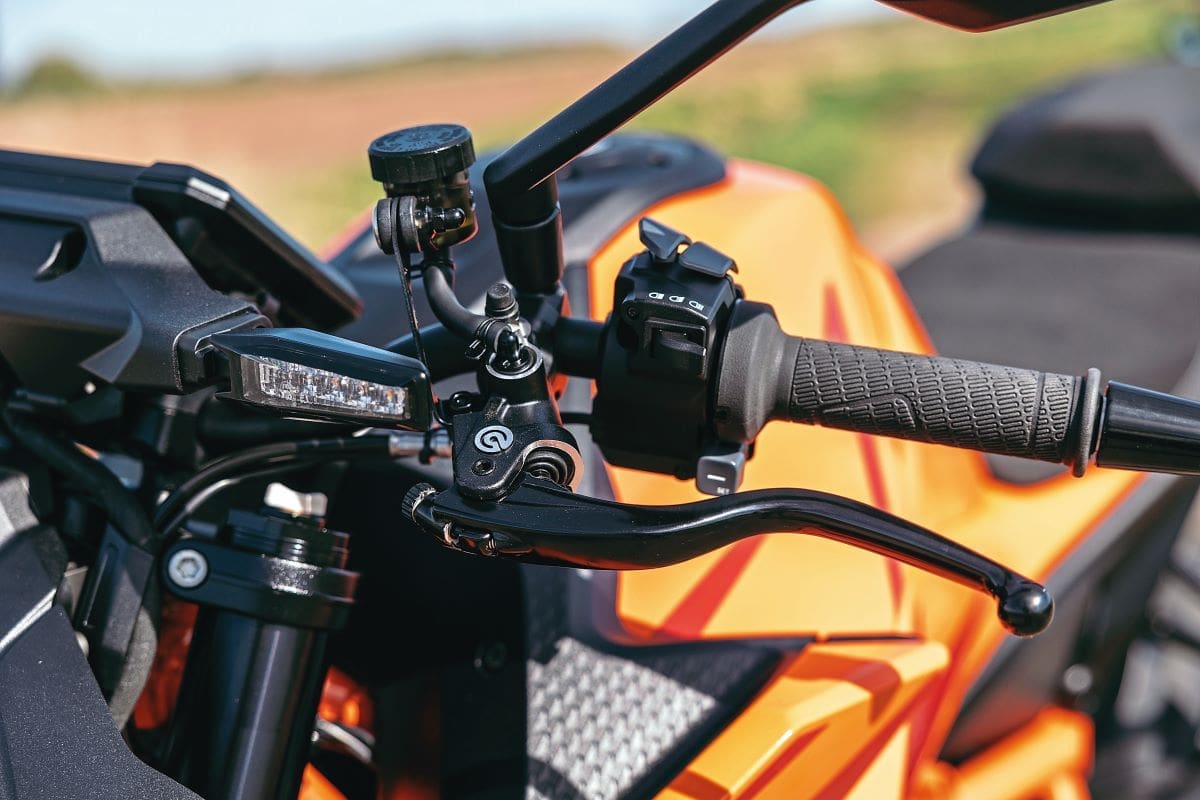
Fuel consumption after a day of mixed riding around the Wolds (both Lincs and Yorks flavours) was 48mpg, and while the predicted range on the dash had started out saying that I’d get 180 miles from the tank, that optimistic reading soon changed when half a tank had been consumed, but I reckon a genuine 150 mile range can be expected without any worry, and while this isn’t exactly a ground-breaking figure, and will certainly be mocked by those folk who have continent-crossing ambitions, it is reasonable enough for bike of this style (and seat thickness), and you do have to remember that this is close to being double to tank range of that very first Super Duke….
The choice of the sports-focussed Michelin Power GP rubber as standard fitment perhaps shows exactly where KTM are aiming this bike – with track days in mind perhaps, although there are softer, grippier tyres that would be the preferred option for time-served track day addicts. From a personal perspective, given the abilities of modern sports touring rubber (and the vagaries of the British weather!), I would be fitting something with a little more tread and water-dispersion abilities, but it has to be said that the standard fitment rubber is pretty impressive, even on some early morning cold and damp roads (note – not wet, just damp).
I’ll finish off with a final reference to the styling. Or, to be more precise, the way the styling appears to effect the aerodynamics. Thanks to the effects taking place on the environment there are far fewer bugs, flies and insects buzzing around our countryside nowadays, and it’s worryingly rare I find myself having to clean my visor during a ride out, regardless of how far I cover. However, the Spring of 2025 has seen something of a return to splattered visors and fairings presumably thanks to the remarkably clement and dry star to the year. And my visor got truly splattered over the half day ride up to Helmsley, yet there was little in the way of dead invertebrates on the bodywork, so I can only suggest the headlight and surrounding bodywork are funnelling the bugs inwards and upwards directly at my fizzog. There didn’t seem to be any other aerodynamic effect though, no undue buffeting, no extreme noise. Just bugs. Lots of bugs. Maybe they’re attracted to the insectivorous headlight arrangement? Come to daddy!…

Frame: While a certain Italian manufacturer have forgone the tubular steel frame nowadays, KTM have retained the classic construction that is – clearly – eminently suitable for a relatively narrow angle vee twin.
Engine: At 675cc per cylinder, this is a big, lusty powerplant, and not only is the peak power output impressive for just two cylinders, those two huge pistons deliver little in the way of intrusive vibration – just lots (and lots) of frantic acceleration.
Suspension: The R version has conventional – albeit highly tuneable – suspension, but there is the Evo version that has the electronic WP Semi-Active suspension that automatically adjusts to suit the conditions (or your input). But it’ll cost you and extra £1,600.
Tech: It’s not the only big power naked bike to have a plethora of technology in its arsenal, with all manner of traction, wheelie, power and engine braking options, for the Speed Triple RS and Streetfighter V4 are also thus equipped.
Styling: If there’s one thing that folk are talking about more than the wheelie control, it’s the style. It certainly divides opinion! The angular, insectile and aggressive front end gives you no doubt as to what manufacturer built this bike and that, in my mind, is a good thing. Nobody wants a bike that looks like every other bike on the road…
Price – While the list price is a couple of bags of sand short of twenty large, the company are currently offering a wide variety of ever-changing deals in order to keep stock flowing out of their showrooms and warehouses. Throughout the KTM range there are some stunning bargains.

Specification
Make and model: KTM 1390 Super Duke R
Price: £17,999 (note – deals are available!)
Engine: 1350cc, 75° vee twin, water-cooled, 4 valves per cylinder, variable valve timing
Power: 190bhp (141.7kW) @10,000rpm
Torque: 107lb-ft (145Nm) @ 8,000rpm
Frame: tubular steel, cast aluminium/composite rear subframe
Wheelbase: 1491mm
Rider aids: Street, Sport & Rain rider modes (Track & Performance modes at additional cost) 6 axis IMU, cornering ABS & traction control etc
Brakes: (F) 4 piston Brembo Stylema calipers, 320mm discs, (R) twin piston caljper, 240mm disc
Transmission: 6 gears, chain final drive
Suspension: (F) 48mm WP Apex forks, compression, rebound & preload adjustable, 125mm travel, (R) WP Apex shock, high & low speed compression damping & preload adjustment, 140mm travel.
Wheels/tyres: (F) 3.5” x 17” cast aluminium wheel, 120/70×17” Michelin Power GP tyre, (R) 6.0×17” cast aluminium wheel, 200/55×17” Michelin Power GP tyre.
Seat height: 834mm
Fuel capacity: 17.5 litres
MPG: 48mpg (tested)
Weight: 200.5kg (no fuel)
Warranty: Two years
Service intervals: valve clearance 37,200 miles
Contact: www.ktm.com
Many bargains, much cheapness
While it’s also mentioned in the spec and the annotations hereabouts, KTM are continuing their range of deals on all of their models and, at the time of writing (May 12), the offer on the Super Duke R is a reduction in price of £2,700, giving a retail of £15,299, while an initial deposit of £3,074 opens up PCP payments of just £139 a month. All of sudden, the utter lunacy of the 1390 appears affordable…

